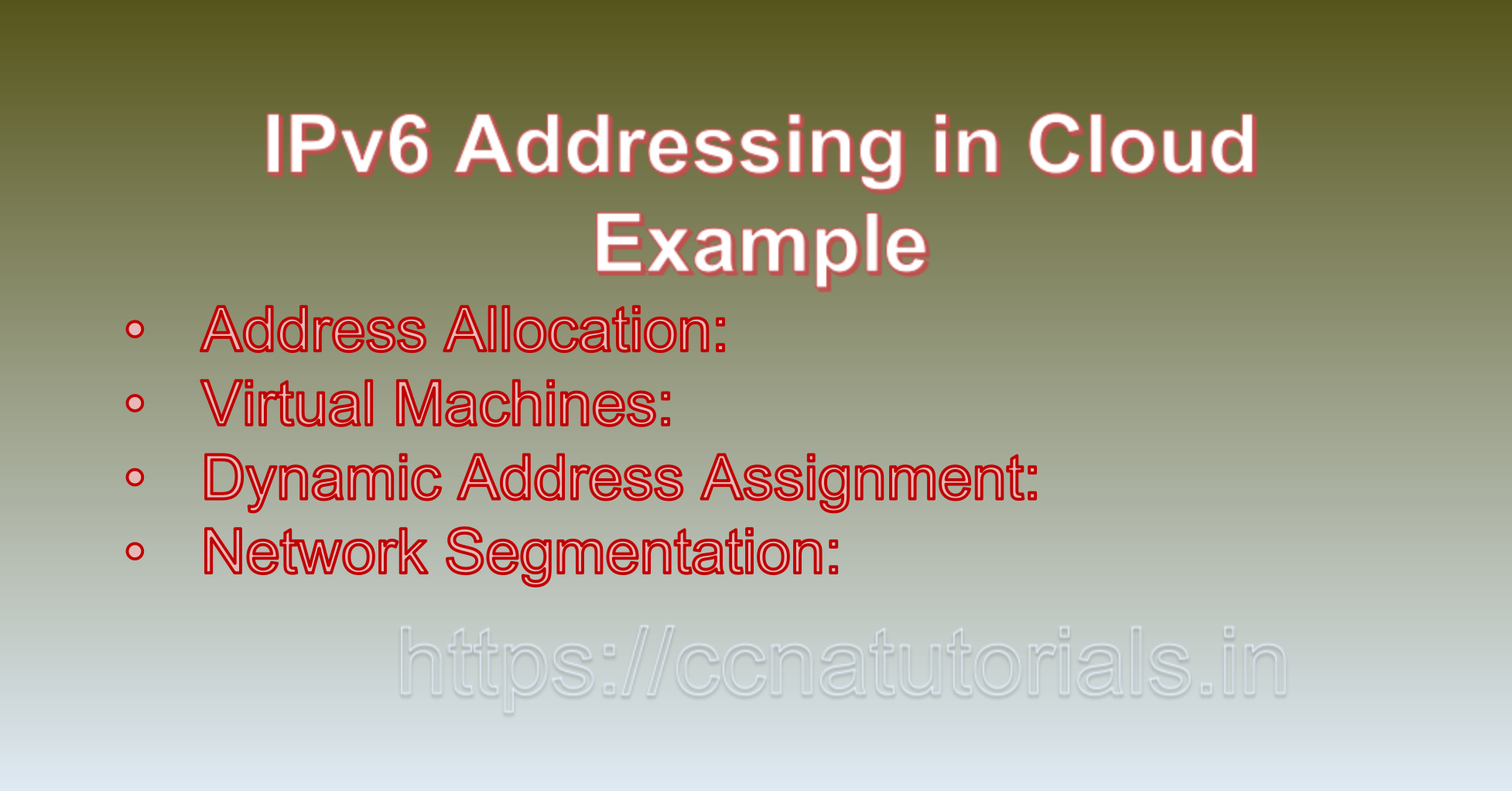Contents of this article
In this article, I describe IPv6 Addressing in Cloud Environments: Enabling Scalable Connectivity. IPv6 addressing plays a vital role in cloud environments, providing the foundation for seamless communication between resources hosted in the cloud. As organizations increasingly leverage cloud services for scalability, flexibility, and cost-effectiveness, understanding IPv6 addressing in cloud environments becomes essential. This article provides an overview of IPv6 addressing in cloud environments, its significance, and real-world examples to illustrate its importance.
IPv6 Addressing in Cloud Environments:
IPv6 addressing in cloud environments involves assigning unique IPv6 addresses to various cloud resources, including virtual machines, containers, and services. Cloud providers allocate and manage IPv6 address ranges for their customers’ virtual networks, enabling efficient connectivity, resource isolation, and network segmentation.
Key Aspects of IPv6 Addressing in Cloud Environments:
1. Address Allocation:
Cloud providers allocate blocks of IPv6 addresses to customers based on their subscription plans. These addresses are used for both internal and external communication.
2. Resource Identification:
IPv6 addresses uniquely identify cloud resources, ensuring that each resource is reachable and distinguishable in the network.
3. Dynamic Address Assignment:
Cloud environments often employ dynamic address assignment mechanisms, such as DHCPv6, to streamline the provisioning of IPv6 addresses to virtual machines and other resources.
4. Network Segmentation:
IPv6 addressing enables the creation of virtual networks with separate IPv6 address ranges, allowing organizations to segment their cloud resources for security, performance, and management purposes.
IPv6 Addressing in Cloud Example:
Consider an organization that uses a cloud provider to host its applications and services. In this scenario, IPv6 addressing is crucial for enabling connectivity:
1. Address Allocation:
The cloud provider allocates a block of IPv6 addresses to the organization. This block will be used to assign unique IPv6 addresses to virtual machines and services.
2. Virtual Machines:
When a new virtual machine is deployed in the cloud environment, it is assigned an IPv6 address from the allocated address range. This address allows the virtual machine to communicate with other resources in the cloud.
3. Dynamic Address Assignment:
DHCPv6 may be used to dynamically assign IPv6 addresses to virtual machines as they are created. This simplifies the address assignment process and ensures efficient resource utilization.
4. Network Segmentation:
The organization creates multiple virtual networks within the cloud environment, each with its own IPv6 address range. This segmentation enhances security by isolating different components of the organization’s infrastructure.
Importance of IPv6 Addressing in Cloud Environments:
1. Scalability:
IPv6 addressing accommodates the massive scale of cloud environments, enabling the allocation of unique addresses to a large number of resources.
2. Resource Isolation:
Each cloud resource is assigned a unique IPv6 address, allowing for isolation and communication between resources while maintaining network security.
3. Network Segmentation:
IPv6 addressing supports network segmentation within cloud environments, enabling organizations to define separate address ranges for different virtual networks and services.
4. Efficient Communication:
IPv6 addressing ensures efficient and direct communication between cloud resources, minimizing latency and optimizing performance.
In short IPv6 Addressing in Cloud Environments:
IPv6 addressing is a fundamental aspect of cloud environments, providing the foundation for seamless communication and resource allocation. Cloud providers allocate IPv6 address ranges to customers, enabling dynamic address assignment, network segmentation, and efficient communication between cloud resources. As organizations embrace cloud computing for its scalability and flexibility, understanding and effectively managing IPv6 addressing in cloud environments is crucial. Real-world examples illustrate how IPv6 addresses are allocated, assigned, and used within cloud environments to ensure effective connectivity and resource management. By mastering IPv6 addressing in the cloud, organizations can fully leverage the benefits of cloud services while maintaining efficient and secure communication across their virtual networks.

IPv6 Addressing in Cloud Environments: Scaling Connectivity in the Digital Era
IPv6 addressing in cloud environments is a critical consideration as organizations leverage cloud computing to scale their operations, accommodate growing workloads, and meet the demands of the digital age. Cloud environments offer flexibility, scalability, and efficiency, and IPv6 plays a pivotal role in ensuring seamless connectivity and communication within these environments. This article provides an overview of IPv6 addressing in cloud environments, its significance, and real-world examples to illustrate its importance. IPv6 addressing in cloud environments refers to the allocation and management of IPv6 addresses for virtual machines, containers, services, and resources within cloud platforms. As organizations migrate workloads to the cloud, adopt containerization, and embrace serverless architectures, IPv6 addressing ensures that cloud resources can communicate efficiently and that connectivity scales seamlessly to accommodate the dynamic nature of cloud deployments.
Key Aspects of IPv6 Addressing in Cloud Environments:
1. Auto-Configuration:
IPv6 supports stateless auto-configuration, allowing cloud resources to generate their own IPv6 addresses without relying on manual configuration or DHCP servers.
2. Global Reachability:
IPv6 addresses offer a larger address space, enabling cloud resources to have globally reachable addresses without the need for NAT (Network Address Translation).
3. Subnetting:
Cloud environments often involve subnetting to segment resources for security, isolation, and efficient management. IPv6 subnetting techniques, such as hierarchical addressing and IPv6 prefixes, apply in cloud networks.
4. Dynamic Scalability:
Cloud environments demand dynamic scaling of resources. IPv6 addressing supports this by enabling new instances or containers to acquire unique IPv6 addresses as they are provisioned.
5. Multi-Tenancy:
Cloud providers serve multiple tenants on shared infrastructure. IPv6 addressing ensures that each tenant’s resources can have distinct and routable addresses while maintaining isolation.
IPv6 Addressing in Cloud Example:
Consider a scenario where an organization is using a cloud service provider to host its web application. The organization’s cloud environment consists of virtual machines (VMs) and containers that need to communicate with each other and the external world using IPv6 addressing:
1. Auto-Configuration:
As VMs and containers are spun up, they automatically generate unique IPv6 addresses based on their MAC addresses. This eliminates the need for manual address assignment.
2. Global Reachability:
Each VM and container is assigned a globally reachable IPv6 address, allowing them to directly communicate with other devices on the Internet without NAT.
3. Subnetting:
The organization sets up IPv6 subnets to segment VMs and containers. For example, VMs serving the front-end of the application might be in one subnet, while those handling the back-end are in another.
4. Dynamic Scalability:
When the application experiences increased traffic, the cloud environment dynamically scales by provisioning additional VMs and containers. Each new instance automatically receives its unique IPv6 address.
5. Multi-Tenancy: The cloud provider ensures that each organization’s resources are isolated. IPv6 addressing allows different organizations to have distinct IPv6 addresses for their VMs and containers within the same cloud environment.
Importance of IPv6 Addressing in Cloud Environments:
1. Efficient Communication:
IPv6 addressing enables efficient and direct communication between cloud resources, eliminating the need for complex NAT configurations.
2. Scalability:
Cloud environments require the ability to scale resources rapidly. IPv6 addressing supports dynamic provisioning of resources with unique addresses.
3. Global Connectivity:
IPv6’s larger address space ensures that cloud resources have globally reachable addresses, enhancing connectivity for applications serving a global user base.
4. Resource Isolation:
IPv6 addressing supports multi-tenancy by allowing cloud tenants to have isolated, routable addresses for their resources.
Conclusion for IPv6 Addressing in Cloud Environments:
IPv6 addressing in cloud environments is a fundamental aspect of modern networking as organizations leverage cloud computing to achieve scalability, efficiency, and flexibility. The adoption of IPv6 within cloud environments ensures that resources can efficiently communicate with each other and the external world, even as workloads dynamically scale and cloud deployments evolve. Real-world examples demonstrate how IPv6 addressing enables auto-configuration, global reachability, subnetting, dynamic scalability, and multi-tenancy in cloud environments. As businesses continue to embrace cloud computing to drive innovation and growth, understanding the role of IPv6 addressing is essential for building robust and interconnected cloud infrastructures that can effectively meet the demands of the digital era. You may contact us or drop a comment below related to this article.






